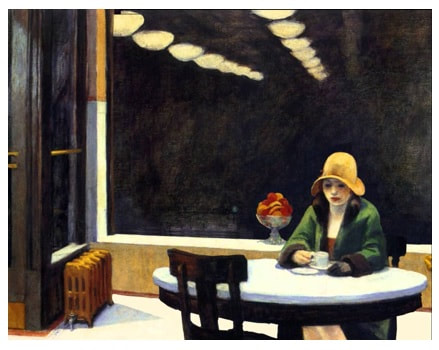Year 11 are working on the Original Writing task for GCSE Paper 1 at the moment, and we spent today’s lesson looking at how to explore an image. There are dozens of ways you can approach this task, and I’m sure people have their favourite methods, but I thought I’d write about this lesson because it’s a lovely way of getting students to generate ideas.
A couple of days ago, I read codexterous’s blog post on creative writing icebergs, and thought that this was a brilliant way of getting students to think about an image that I’ve used for years as a creative writing prompt, Edward Hopper’s 1927 painting Automat. So the Do Now task for today’s lesson was the following slide:

The students very quickly came up with the idea of isolation, and the idea that both images conveyed a sense of cold, whether physical or metaphorical. I prompted them to think of what they knew about icebergs, and from then it was an easy jump to the idea of surfaces and what lies beneath: the fact that you can look at Hopper’s image and have no idea what’s going on in the woman’s mind, or in her life, to bring her to this lonely café.
We then started to look at the painting in more depth. I asked the students to spend a couple of minutes simply writing down what they could see. It was fascinating to see how closely they read the image. They began with obvious points: a woman wearing a green coat and a yellow hat, sitting alone at a table in a café, with a window behind her in which two rows of lights are reflected in the darkness. Then they started to focus on particular details. One of them pointed out that the warmth of the colours: the reds, oranges and yellows. Another picked up on the empty chair opposite the woman. There was a lot of discussion of her clothes. Her coat looks expensive, with a fur collar and cuffs. Her dress is short and low-cut: she looks as if she’s dressed for a night out. She doesn’t have a bag with her. She’s wearing only one glove. She’s looking into her cup of coffee with a downcast expression on her face, emphasised by downward curve of the brim of her hat. I get students to think even further, about the things they can’t see: how much coffee is left in her cup, what time it might be, whether the table is clean or a little bit sticky.

From this point, questions abound. Why is she there? Is she on her way to somewhere, or is she going home? If she’s on her way somewhere, does she know where she’s going? How long has she been there? Was there someone sitting opposite her earlier? Has there ever been someone sitting opposite her? Is she running away from something? Why is she so dressed up? Has the person behind the counter noticed she’s there? Are they keeping an eye on her, concerned, wondering whether they should ask if everything’s okay?
We’re going to spend more time developing this piece of writing next week, but today we finished by focusing on that cup of coffee. I asked the students to imagine that they were looking at it, from the woman’s point of view, and to describe it. We shared our ideas, and one student came up with the brilliant idea that it had originally had a heart drawn in the foam on top, but that now the heart had disintegrated, leaving the woman with nothing but the dregs. We talked about what kinds of sentence structures might help us to create a sense of bleakness and despair, and decided that some single-words sentences, and short simple sentences, might be useful. Then we had five minutes to write a description, and I wrote alongside the students. Here’s what I came up with:

There wasn’t time for us to share our work, but that will be the starting point for next lesson. We’ll then think about how to structure a longer piece of writing, using drop-zoom-flash-end as a scaffold. Lots of thinking, lots of rich discussion and hard imaginative work, but the kind of lesson that passed by very quickly.
This post is featured by Twinkl in their ‘Teaching Writing’ blog
